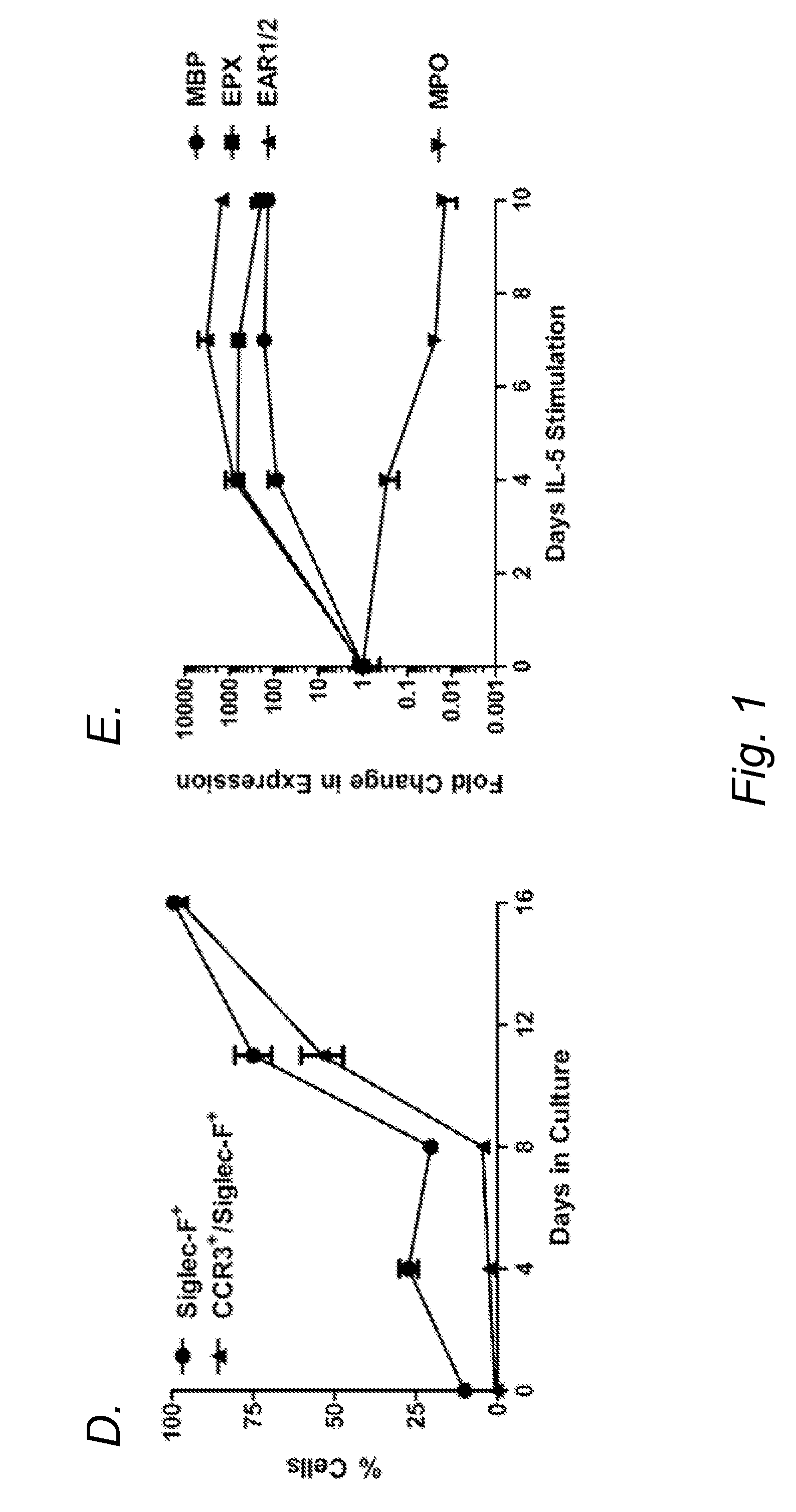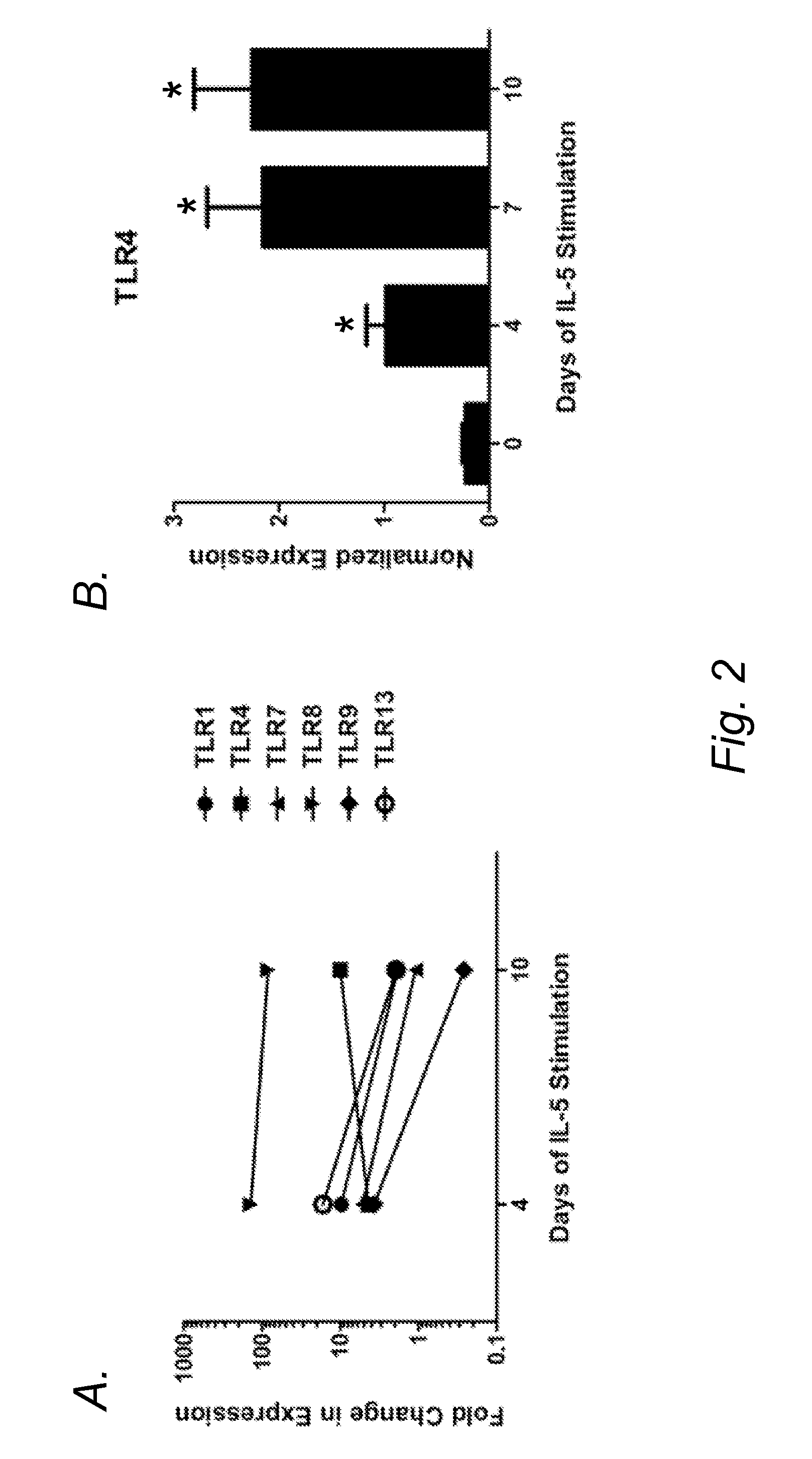Blockade of eosinophil production by toll-like receptors
a toll-like receptor and eosinophil technology, applied in the direction of viruses/bacteriophages, biocide, drug compositions, etc., can solve the problems of marked increase in eosinophil counts, and achieve the suppression of eop proliferative response, reduction of eosinophil production, and reduction of the number of cells
- Summary
- Abstract
- Description
- Claims
- Application Information
AI Technical Summary
Benefits of technology
Problems solved by technology
Method used
Image
Examples
example 1
Production of Mature Eosinophils Via an Ex Vivo Liquid Culture System
[0060]An ex vivo culture system of whole bone marrow that results in functionally competent eosinophils was recently described (Dyer, et al. J. Immunol. 181:4004-9 (2008)). To investigate molecular regulators of eosinophil differentiation, the culture system was adapted to start with low-density bone marrow (LDBM) cells.
Mice
[0061]In-house bred, four- to six-week-old, male and female wild-type BALB / c mice were used as a source of bone marrow cells unless otherwise indicated. Wild-type C57BL / 6 (CD45.1) and TLR4-deficient mice (C57BL / 6, CD45.2) (The Jackson Laboratory, Bar Harbor, Me.) were allowed to acclimatize for at least 2 weeks prior to use. All mice were housed under specific pathogen-free conditions and treated according to institutional guidelines.
Murine Eosinophil Liquid Cultures
[0062]The femurs and tibiae of mice were crushed in a sterile mortar and pestle containing 1×PBS with 2% FBS, and cells were collec...
example 2
TLR Expression in Developing Eosinophils
[0072]Previous studies have demonstrated TLR4 expression on a percentage of by early hematopoietic progenitors and by mature eosinophils (Nagai, et al. Immunity 24:801-12 (2006)). Despite the challenge in detecting TLR4 on the surface of these rare cells, a response to a TLR4 ligand was noted with sorted HSCs and GMPs from which EoPs arise (Nagai, et al. Immunity 24:801-12 (2006)). Mature eosinophils have been shown to express the transcripts for a number of different TLRs, including TLR4 (Nagase, et al. J. Immunol. 171:3977-82 (2003); Plotz, et al. Blood 97:235-41 (2001); Sabroe, et al. J. Immunol. 168:4701-10 (2002)), although most mature eosinophils from wild-type mice and normal human donors have no detectable surface expression of TLR4 despite detection of mRNA expression (Nagase, et al. J. Immunol. 171:3977-82 (2003); Sabroe, et al. J. Immunol. 168:4701-10 (2002); Wong, et al. Am. J. Respir. Cell. Mol. Biol. 37:85-96 (2007); Driss, et al...
example 3
Inhibition of IL-5-Induced Eosinophil Production by TLR4 Activation Via LPS or LPS Mimetic
[0088]EoPs were found to express TLR4 (Example 2). Therefore, a subsequent study was designed to explore the functional response of EoPs to TLR4 activation.
Results
[0089]Developing eosinophils were exposed to the TLR4 ligand LPS for 18-24 hours after 4 days of IL-5 stimulation and subsequently continued with IL-5 stimulation alone for the remaining 6-7 days of culture (FIG. 3A). Treatment of developing eosinophils with LPS resulted in a dose-dependent reduction in total eosinophil yield in the culture (FIG. 3B). Although LPS exposure significantly reduced the eosinophil yield, IL-5-mediated differentiation of developing eosinophils was unaffected, as evidenced by the unchanged percentage of cells expressing Siglec-F (FIG. 3C).
[0090]As LPS preparations can contain bacterial products that stimulate multiple TLR signaling pathways, developing eosinophils were treated with an ultrapure preparation o...
PUM
 Login to View More
Login to View More Abstract
Description
Claims
Application Information
 Login to View More
Login to View More - R&D
- Intellectual Property
- Life Sciences
- Materials
- Tech Scout
- Unparalleled Data Quality
- Higher Quality Content
- 60% Fewer Hallucinations
Browse by: Latest US Patents, China's latest patents, Technical Efficacy Thesaurus, Application Domain, Technology Topic, Popular Technical Reports.
© 2025 PatSnap. All rights reserved.Legal|Privacy policy|Modern Slavery Act Transparency Statement|Sitemap|About US| Contact US: help@patsnap.com



